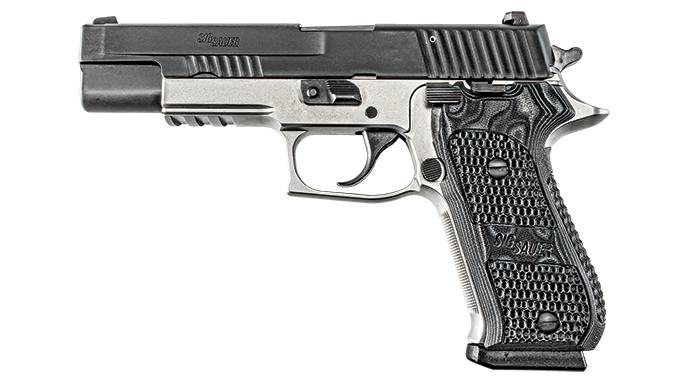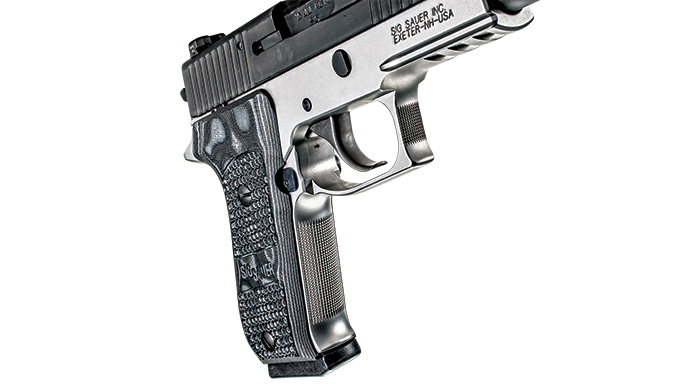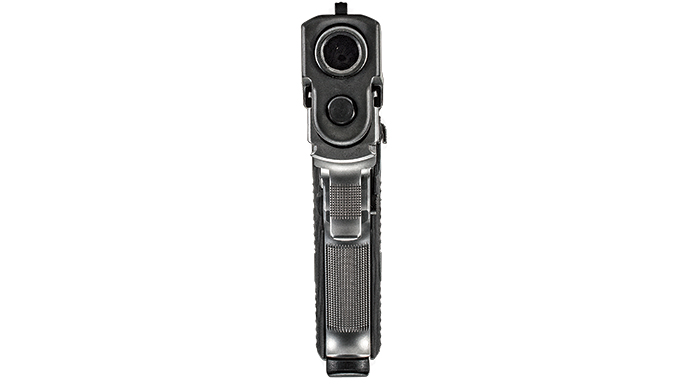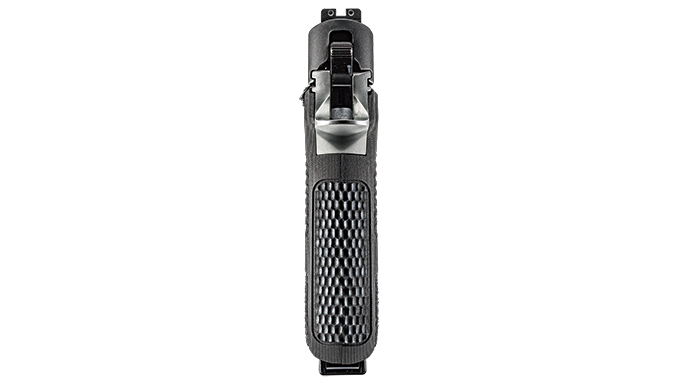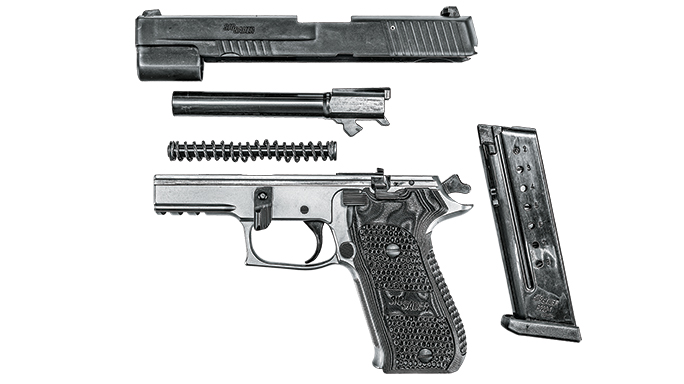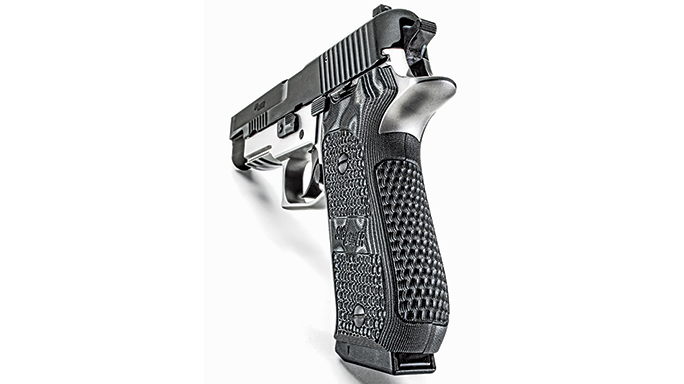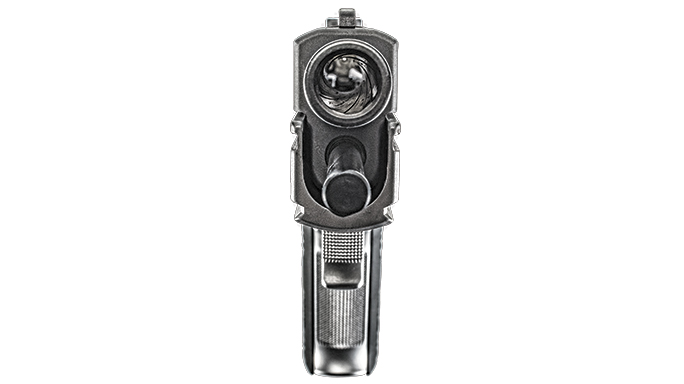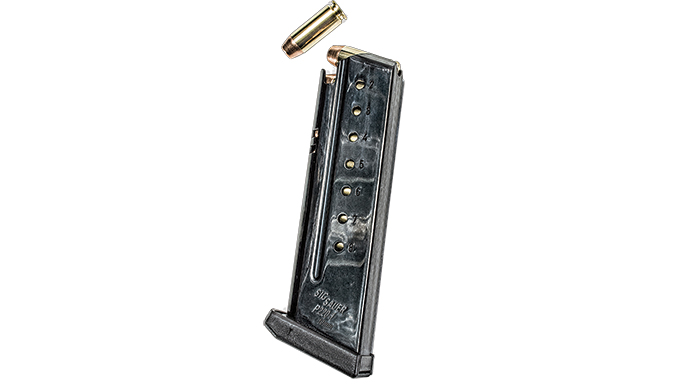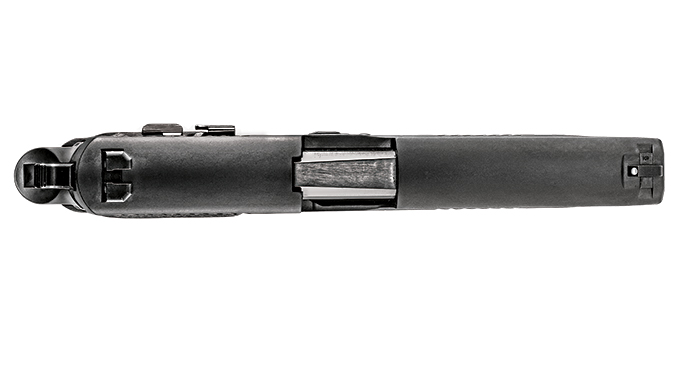The difference between 9mm and 10mm projectiles is roughly the thickness of a dime. That doesn’t sound like much… but is it? If you’re talking about the thickness of coins, then no, not really. But if you’re talking about the caliber of centerfire pistol cartridges, it could make a world of difference. The 9mm Parabellum is in widespread use in many roles with national armies as well as private citizens. Though its effectiveness has been debated time and time again [See Round Table: 9mm vs. .45 ACP in Ballistic issue No. 1], it is rapidly becoming the go-to round for many in the firearms community. For those nonbelievers, there’s an alternative, and we’re not talking about .45 ACP.
- RELATED STORY: Sig Sauer Releases 10mm Elite Performance Ammo
One round that is not used nearly as much as either 9mm or .45 but is a heck of a lot more ballistically effective is 10mm Auto. Just one millimeter separates the projectile diameter of the 9mm and 10mm (admittedly that’s a less than complete description, but you get the idea), and yet the latter is powerful enough to be approved for use in pistols to take down white-tailed deer in many states. The 10mm’s stopping power is well documented, and as a testament to its effectiveness, the Danish Navy has even issued 10mm pistols as a defense against polar bears in Greenland.
The Swiss Army Knife Of Guns
Advertisement — Continue Reading Below
Originally released in 1975 and chambered in 9mm for use by the Swiss Army, the P220 is considered by many to be one of the finest handguns Sig Sauer has ever created. Its purpose was to replace the aging P210, which had been in service since the late 1940s. The P220 was an instant success due to its uncompromising reliability (just like a Swiss watch!). Early on, the P220 was available in multiple calibers, including 9mm, .45 ACP and .38 Super. The .38 Super chambering went by the wayside quite some time ago, and in the ’80s, the 9mm variant led to the development of Sig’s popular P226 model.
Today, the P220 is only available in .45 ACP. Well, we should write “was available,” because earlier this year, Sig unleashed the big-bore P220 Elite, chambered for the all-business, all-the-time 10mm Auto cartridge. Perfect for those looking for a pistol that can stop an intruder (or polar bear, for that matter), the 10mm version of the P220 will be released in four versions as well as a companion line of Sig Sauer Elite Performance Ammunition that includes two versions of the 10mm cartridge. We recently had the good fortune to spend some quality time with the P220 Match Elite Reverse Two-Tone version of Sig’s newest 10mm offering.
Quality From The Frame Up
Advertisement — Continue Reading Below
The success of Sig’s Elite series is based on its stainless-steel frame. The added strength from stainless-steel construction (compared to the lighter alloy frame of a standard P220) boosts weight, which helps lower felt recoil. Steel also means the frame will hold up better to the stresses incurred from a stout cartridge. This is a great benefit for .45 ACP, but an absolute must for the powerful 10mm Auto.
The Match Elite Reverse Two-Tone has a black slide and a stainless-finished frame with an Elite Beavertail to allow you to get a high grip, closer to the pistol’s bore line. This feature also won’t let the slide or hammer bite you while shooting. The high grip is a huge advantage since the 10mm creates a Significant amount of recoil.
The frame feels relatively thin and is fitted with excellent Hogue G10 Piranha grips finished in a tactically fashionable black and gray. They are cut to fit flush under the beavertail and extend around the sides. This is an excellent fitment with nearly no felt transition from grip to frame on the backstrap. The front strap is checkered with 25 lines per inch and will further aid in a good grip on the P220 Match Elite. If you have smaller hands, this gun will not be difficult to grip, though controlling the 10mm’s recoil may be a bit of a challenge.
Advertisement — Continue Reading Below
Inside the large triggerguard is a Double Action/Single Action (DA/SA) trigger. Love them or hate them, Sig has always done a good job with these types of actions. The weight of the DA trigger pull is roughly 10 pounds, while the SA pull is 4.4 pounds. The DA pull of this sample was smooth as expected and allowed us to easily keep the sights on target through the longer and heavier stroke. Once in SA mode, the trigger was light and crisp. It’s hard to describe the break of a Sig SA trigger. It’s something you must feel to truly appreciate. Because of its DA/SA nature, the frame also features a decocker on the left side that safely drops the hammer without firing a chambered round. Right behind the decocker is the slide release lever, exactly where it has always been conveniently located on Sig pistols.
The front end of the frame has three rail sections cut into it. This allows you to fit a number of accessories, such as a light or laser. The P220’s steel, single-stack magazines hold a total of eight rounds, giving you a total complement of nine rounds if you load an additional cartridge into the chamber.
Slide Right
Advertisement — Continue Reading Below
Sig Sauer’s slide is unmistakable, whether in person or on the big screen. Its beefy, rectangular shape and smooth, rounded top is visually distinctive and never gets old. The slide is comprised of stainless steel with short cocking serrations at the front and complementary larger serrations at the rear. The serrations really improve grip on the slide when cycling the action, which is especially important since the recoil spring is rather stiff due to that ten-double-m punishment.
The right side of the Match Elite’s slide has a loaded chamber indicator and is topped with three-dot SigLITE night Sights. These tritium-insert, glowing Sights are very useful when trying to acquire the Sights in low-light conditions. The barrel is 5 inches long and releases the 10mm projectile at more than 1,200 feet per second (fps).
Happy Bore More
Advertisement — Continue Reading Below
We wanted to understand why Sig would introduce a new P220 in 10mm Auto. Let’s face it, this is a monster cartridge, and some may say more of a niche round. It’s not exactly low-recoiling, and it’s harsher on the internals. Some of us have never actually fired a 10mm. Some have never had the desire to. So, for whom is this gun meant? Well, when looking at Sig’s full line of 10mm P220 offerings, it seems like the answer is “everyone.”
The 10mm-chambered P220 is offered in three other configurations besides this Match Elite Reverse Two-Tone. The Stainless Elite Nitron is SA only and black with black G10 Piranha grips. It also gets a Nitron coating. This proprietary finish has DLC (Diamond-Like Carbon) properties and should give the P220 resistance to wear, and it has some lubricious qualities as well. The Stainless Elite is also SA only, and has a stainless finish with rosewood grips. Another version is the SA only P220 Hunt Ready. This model is ready to go from the box to the hunt with nothing else needed and includes a Sig Sauer Romeo mini red-dot reflex sight attached on top of its slide. The Hunt Ready is finished in a very cool-looking Kryptek Highlander camo. It seems that the P220 Match Elite 10mm is ideal for competition, hunting, target shooting and personal defense.
When comparing the P220 Match Elite 10mm to the .45 ACP, you find the guns themselves are nearly identical – same frame, action and magazine capacity. There are some small internal parts differences, but overall, they’re similar guns. So choosing one over the other comes down to your personal caliber preference and desired performance. The 10mm is a strong, flat-shooting cartridge with a velocity of over 1,200 fps out of the P220. Sig’s 180-grain 10mm projectile makes 40 percent more muzzle energy than its 230-grain .45 ACP and 35 percent more than the 185-grain version of the .45 ACP.
Advertisement — Continue Reading Below
Simply put, the 10mm bullet hits harder. But that benefit also brings some disadvantages. For many, the 10mm can be harder for shooting accurate follow-up shots as fast as when using a .45 ACP. There’s also a cost factor: 10mm ammunition typically costs more than .45, so that’s something to keep in mind, too.
Shooting Impressions
We had some initial nervousness before shooting the P220 Match Elite. Was all this apprehension warranted? Not at all. This pistol actually shoots very comfortably. Though increased muzzle rise as compared to a .45 was very apparent, it was far from uncontrollable, and – good news – there was no stinging of our tender mitts. The Match Elite only gave the shooter a good push.
Advertisement — Continue Reading Below
The P220 10mm’s recoil can best be described as the recoil of a .45 ACP on mild steroids; perhaps a .45 ACP ++P, if you will. Controlled pairs at 7 yards were easy enough if you did your part and waited for the Sights to come back on target. The pistol felt good in the hands, and the narrow grip and frame made it easy to get both hands on it. The Elite’s Beavertail is excellent and did its job well. We shot a couple of groups from 25 yards using Sig’s 180-grain 10mm Elite Performance FMJ and were able to group a six-shot string into 1.5 inches.
- RELATED STORY: Sig Sauer’s MCX Rifle: An Elite Modular Weapons System
Shooting this beast was pleasant, and lots of fun. But had we done that, the results might not have been as good as those with the Sig P220 Elite 10mm.
The Bottom Line
Advertisement — Continue Reading Below
Sig Sauer’s P220 Match Elite line of pistols chambered in 10mm Auto gives shooters some solid options when considering this knockdown caliber. The pistol’s build quality is typical of Sig, which is to say that it’s impeccable in terms of fit, finish and function. However, this high level of craftsmanship and quality materials does come with a cost. The P220 as featured carries a retail price of just over $1,400, which isn’t chump change. But when it’s time to get down to business, the price of admission is well worth it.
For more information, please visit SigSauer.com.
